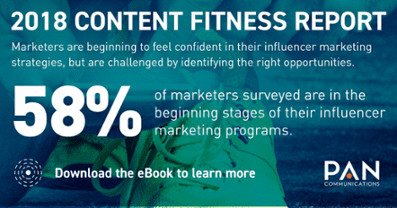Influencer marketing is no longer a niche option for brands. It has great opportunities to grow in B2B, it can be managed, it can be measured – and it will make a big contribution to solving the perennial content problem (good content is expensive, and there’s never enough of it).
It’s no coincidence that influencer marketing sits at the heart of the 2018 Content Fitness Report from PAN Communications. Literally, it’s the central section of the report, and it rightly infiltrates the report’s other main themes: content strategy, budgeting, visualization, and ROI. We’ll see how the power of voice influences content marketing across the board, from planning to metrics, but first let’s break influencer marketing down.
Only six percent of marketers said they had an “advanced” influencer program, with the majority identifying as having “beginner” or “intermediate” strategies in place.
 What influencer marketing is
What influencer marketing is
Influencer marketing leverages the recognition and credibility an individual has with a specific audience to promote a product or service to that audience. The audience follows the influencer because of some perceived affinity – in a broad sense, they’re advocates. Influencer marketing is likely to be effective where there is also an unforced affinity between the influencer and the product or service – an affinity readily communicated to followers.
Affinity goes hand-in-hand with credibility. A B2B influencer with a background in technology or tech design, writing about, say, Apple products, will be compelling for an audience which has an affinity with that brand. The same influencer, no matter how devoted his/her following, might be less persuasive as an advocate for financial services, healthcare, or security.
What influencer marketing is not
One thing to remember is that influencer marketing is not the same thing as celebrity endorsements. Influencer marketing is distinct from the adoption of a famous face as a brand ambassador, and it needs to be viewed, treated, and managed differently. In any case, not all products and services are a natural fit for celebrity endorsements, and certainly a celebrity isn’t necessarily a natural fit for a brand just because he or she is famous. In the B2B space, just because Gary Vaynerchuk or Kara Swisher enjoy celebrity status in their spheres, it doesn’t mean they would make good advocates for your brand.
The influencer relationship is – or should be – one of several ongoing engagements between the influencer and his/her audience, with branded products or services organically surfacing in the course of engagement. It’s not just taking a selfie with your CMO (although yes, that can happen).
Age of the micro-influencer
All of which goes to underline the increasing importance of micro-influencers. A macro-influencer is someone who commands a very large, generalized audience. By “generalized,” I mean the audience is not following that influencer because they have some very specific interests in common, but because they very broadly “like” them – their work, their image, their look, their reputation. These are the kinds of followers an Elon Musk, for example, has in spades. They’re not following him just for niche insights into energy conservation, but because they think he’s smart and cool, like a real-life Tony Stark (Iron Man).
Customers are more likely to trust recommendations from people they know over traditional brand messaging.
When it comes to micro-influencers, there’s no limit on how narrow the grounds for affinity might be. Maybe you are deeply interested in the philosophy and ethics behind Artificial Intelligence, or haptic communication use for VR technology. I’ll bet you a dollar there’s someone on social media who knows all about each of those topics and has the photos to prove it. And I’ll win.
Today, there are B2B micro-influencers out there who are engaging audiences very precisely defined by demographics, interests, and behaviors; and those audiences – whether or not they yet know it – harbor affinities for very specific products and services. The first step towards making influencer marketing work is identifying a selection of micro-influencers who are a good fit for your products or services andyour market.
Finding them and scoring them
One thing that’s been hammered into me recently, and not just by vendors selling influencer marketing platforms, is that this is a science. It might be a nascent science, but we already know what we’re looking for, and how to measure success in finding it.
Having a clear, data-driven understanding of the role influencers play in your overall marketing mission will allow your team to make more knowledgeable decisions on budgeting and delivery.
I recently attended a fascinating talk by Ben Donkor, a former Microsoft social intelligence lead, now working out the basics on influencer science at the We Are Social agency. He demonstrated the basics of awarding numerical scores to potential influencers, based on their level of impact (an enduring following might be more valuable than a big, but recently acquired following); their passion for the target product or service (what I’ve called “affinity”); and their concordance with a brand’s image or values. Cost will need to be factored in too, of course; influencer relationships are likely to be paid, and if they are, that should be disclosed.
As for finding potential influencers, there are indeed vendors – both in the narrow influencer marketing management space, and more broadly in social media management – who can not only deliver very extensive lists of potential candidates but can put detailed statistics about their reach and impact at a marketer’s finger-tips. I’ve seen data on hordes of influencers sliced and diced on dashboards: That’s for brands ready to take a deep dive into this strategy.
And don’t forget: A brand’s own workforce might include some great influencers and advocates.
Incentivizing employees to showcase company culture and events can help create more authentic stories about your brand, told by people who work at your organization every day.
Influence for B2B and even ABM
Influencer marketing can complement other marketing initiatives, including account-based marketing (ABM). Together with a micro or macro influencer who has the knowledge to speak to that exact prospect, you create a personalized and relevant touchpoint. It’s become a truism that the greater part of the B2B customer journey now takes place before any contact with a sales representative. What are the touch-points on that pre-sales journey? Information gathering, website visits, whitepapers, live and virtual events – sure – but also peer reviews and conversations with colleagues.
One prime locus, it should go without saying, is LinkedIn. Yes, there are LinkedIn influencers, but there are B2B influencers – whether or not they call themselves that – throughout the social eco-system. Maybe think in terms of thought leaders. And when it comes to ABM, there are thought leaders who more naturally address their C-level peers; others who talk granular product details with fellow practitioners. Successfully matching influencers to multiple targeted personas could set an ABM campaign on fire.
The influence on content
Finally, let’s take a look at how a well-developed influencer marketing strategy can help ease other content-related pain-points.
- Strategy and innovation. If customers typically interact with the brand on social (and therefore likely on mobile), that’s the influencer’s natural habitat. Branded social content strategies will merge neatly with influencer’s voices. If a brand has no social strategy, it’s probably not ready for influencer marketing: Fix that first.
- Yes, there’s a cost involved in contracting with influencers. There’s also a cost – usually a high one – involved in developing original branded content. The actual content assets influencers typically produce will be relatively inexpensive; their value comes from their credibility and authenticity. A home-made video by a trusted expert might be more impactful than a professional video produced by your creative team.
- There’s no magic wand for solving the challenge of accurately measuring ROI on content marketing in general. If anything, attributing conversions to touch-points only gets harder as the customer journey gets more complex. But there are templates and solutions for gauging which content assets drive a prospect further down the funnel (and which have neutral or negative effects), and the influence of influencers should be no harder to measure, assuming their activity is closely tracked (as it will likely need to be for management and payment purposes).
According to a 2017 Linqua study, 78 percent of marketers said that tying ROI to influencer marketing efforts was a major challenge. When determining how your influencer marketing efforts should be attributed, turn to your data to help map out the entire journey, and see where influencers play (or should play) a bigger role.
“A winning content strategy comes down to creating meaningful customer experiences and building better relationships with your potential customers.” That’s the conclusion of this year’s Content Fitness Report from PAN Communications. Harness a brand to credible influencers and understand that being customer-centric may mean speaking through voices the customer actually prefers to hear, and it opens a world of opportunity.




